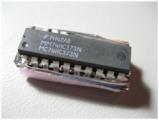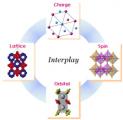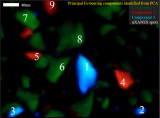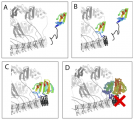The enzyme nitrogenase plays a critical role in converting nitrogen in the air into ammonia, a form that living organisms can use. Scientists have long sought to understand where at the active site of this enzyme, and how, this reaction takes place; among other things, they hope to eventually reverse-engineer it and replace the resource-intensive method widely used in industry with one that mimics nature's gentle version of the reaction.
Approximately 1,700 scientists visit SSRL annually to conduct experiments in broad disciplines including life sciences, materials, environmental science, and accelerator physics. Science highlights featured here and in our monthly newsletter, Headlines, increase the visibility of user science as well as the important contribution of SSRL in facilitating basic and applied scientific research. Many of these scientific highlights have been included in reports to funding agencies and have been picked up by other media. Users are strongly encouraged to contact us when exciting results are about to be published. We can work with users and the SLAC Office of Communication to develop the story and to communicate user research findings to a much broader audience. Visit SSRL Publications for a list of the hundreds of SSRL-related scientific papers published annually. Contact us to add your most recent publications to this collection.
If we could make plant food from nitrogen the way nature does, we would have a much greener method for manufacturing fertilizer; the current industrial process requires such high temperatures and pressures that it consumes about 1.5 percent of the world’s energy. Now scientists working at the Stanford Synchrotron Radiation Lightsource have taken an important step toward understanding how nature performs this reaction, by establishing the nature of a key atom that researchers had sought to identify for more than a decade.
Scientists have deciphered the structure of an essential part of Mediator, a complex molecular machine that plays a vital role in regulating the transcription of DNA. In the course of cellular operations, signals are sent to each cell's DNA asking that some genes be activated and others be shut down. The Mediator transcription regulator accepts and interprets those instructions, telling RNA polymerase II where and when to begin copying sections of the DNA.
The life-sustaining element oxygen can’t do its job alone. Specialized enzymes, containing metallic elements including iron, cause O2to split into two separate oxygen atoms. In this form, oxygen can react with other biological molecules. The precise mechanism of oxygen activation by iron complexes has long eluded researchers, in part because the reaction—which proceeds through multiple intermediate stages—happens in mere fractions of a second.
The structure of human FEN1 as it interacts with a strand of DNA has now been solved by an international team of scientists led by Lawrence Berkeley National Laboratory and the Scripps Research Institute in La Jolla, conducting their work at both the Stanford Synchrotron Radiation Lightsource and the Advanced Light Source. Previous work determined FEN1's structure when not acting on DNA; but how the protein works was not apparent in this DNA-free structure. The recent work, published in the April 15 edition of Cell, reveals how FEN1 goes about its task of removing excess single-strand DNA during DNA replication.
High-temperature superconductors—which conduct electricity without energy loss at relatively high temperatures—are used in advanced technologies including MRI machines, yet their unusual properties are not well understood, preventing the realization of their full application potential. Many of these unusual properties lie in high-temperature superconductors' normal state, the so-called “strange metal phase.” One of the puzzling characteristics of this strange metal phase is an anomalous line shape measured by angle resolved photoelectron spectroscopy (ARPES). ARPES—whether conducted with higher-energy synchrotron or lower-energy laser light—offers information about a material's underlying electronic structure by measuring the energy and trajectory of electrons ejected after the sample absorbs a photon. Yet the two photon sources yield two sets of data that, until now, could not both be described by a single theory.
As cell phones, computers, and other electronic equipment have become part of our daily lives, so too have integrated circuits. Also known as microchips, these semiconductors patterned with trace elements serve as the brains of electronic devices, controlling processes, storing data, and converting information from digital to analog, to name only a few applications. With their increasing prevalence, however, comes the increasing prevalence of malicious attacks. Integrated circuits are susceptible to "hardware Trojans" that can be inserted during production, testing, or distribution to cause failure or compromise the circuit.
New, designer materials—the ones that can carry a charge without depleting it or offer dramatically faster, more efficient computer memory—take advantage of the interplay between the materials’ degrees of freedom (in other words, the parameters that contribute to the materials’ state). One such promising material, made of the elements lanthanum, strontium, and manganese, has previously demonstrated unusual magnetic properties depending on the particular mixture of lanthanum and strontium.
Iron, one of the most abundant metals on Earth’s surface, often dominates the reactivity of rocks, soils and sediments, and is important in many biogeochemical processes. A great challenge for biogeochemists is to identify the iron species in these natural materials at very small scales and to track changes in the iron species as these materials react with water.
Prions are self-propagating protein aggregates that are the infectious element of fatal neurodegenerative disease in mammals. In fungi, however, prions act as protein-based genetic elements. The fungal prion proteins have a so-called prion-forming domain (PFD) that is natively unfolded in its soluble form attached to a globular domain that can regulate the prion in cis. Upon interaction with the prion, an amyloid cross-baggregate form of the protein, the PFD, undergoes a structural rearrangement into an identical amyloid state. While considerable efforts have been devoted to the structural and functional characterization of the PFDs of fungal prions, the mechanistic basis of the cis regulatory effect of the globular domain has been only scarcely studied despite its importance in the prion propagation mechanism.

![Figure 1. (Top) Thermal ellipsoid (50 %) representation of the core atoms of [Fe2(μ-N2H2)]2+ (left)and[Fe2(μ-N2H2)]+ (right). (Bottom left) Overlay of the core atoms of the core atoms of [Fe2(μ-N2H2)]2+ (blue)and[Fe2(μ-N2H2)]+ (purple). (Bottom right) Qualitative MO diagram of the Fe-NH-NH-Fe bond; the p1 and p2 levels are filled for [Fe2(μ-N2H2)]2+; the p3 orbital is singly occupied in [Fe2(μ-N2H2)]+ (red). Figure 1.](https://www-ssrl.slac.stanford.edu/content/sites/default/files/styles/custom-160/public/images/science/highlights/2011/irondiazene-figure1-20111212.png?itok=XcxAY0hP)


![Figure 1. Structure of Fe(III)-peroxo complex, [Fe(TMC)(OO)]+. Hydrogen atoms are omitted for clarity. Key bond distances are shown on the structure. Figure 1.](https://www-ssrl.slac.stanford.edu/content/sites/default/files/styles/custom-160/public/images/science/highlights/2011/metalloenzyme-figure1-20111128.png?itok=o93JbO_8)









